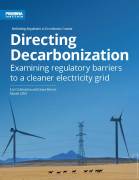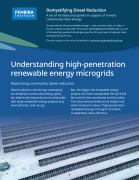- Pembina Institute
- Toxics Watch Society of Alberta
- Western Canada Wilderness Committee
- Environmental Resource Centre
ESBI ALBERTA LTD. APPLICATION NO. 1248859
TRANSMISSION CONGESTION MANAGEMENT PRINCIPLES APPLICATION
Public hearing, May-June 2002
CEC Witness: Mary Griffiths, Ph.D.
OPENING STATEMENT
The Pembina Institute and other members of the Clean Energy Coalition (CEC)1 have chosen to contribute to these proceedings by examining the direct and indirect environmental impacts associated with transmission infrastructure decisions and costs for end-consumers. In our evidence (Exhibit 6-2) and in responses to questions from various parties (Exhibit 6-3), we have indicated principles for congestion management that we believe will minimize the overall environmental impacts from developments in the Alberta Integrated Electric System.2 We have argued that these same principles will also minimize the overall cost to consumers and provide solutions that promote long-term stability of the system. While our detailed comments have already been provided to the Board, we will give a brief overview of our main points in this opening statement.
- Lowest costs and fairness through a market-based system
The CEC believes that a market-based system is the best way to minimize the overall cost to consumers as well as environmental impacts. (It should also ensure that the system is fair to generators.) However, pricing signals in the current system do not reflect the full costs of generating and distributing electricity, nor do they optimize efficiency:
- The current postage stamp tariff for generators requires them to meet only the operating cost of line losses and not the capital costs of transmission from their particular location.
- Fossil fuel generators do not pay the cost of environmental pollution (for example, the cost of air pollution). These "external" costs are borne by society.3
- There are no means to compensate those who reduce system costs by undertaking energy efficiency measures.
We propose principles that reduce the deficiencies in the market system and take into account the environmental impacts of electricity generation and transmission.
- Market signals for new generators and the trading of transmission rights
When it announced plans for deregulation, the government indicated that there would be clear signals to "encourage suppliers to locate facilities for the maximum efficiency of the system."4 With the current postage-rate tariff, generators are not required to consider the full system costs (i.e., generation and transmission) when locating new generation capacity.5 A location that is advantageous to the generator may actually increase congestion and transmission costs, resulting in a higher overall postage-rate tariff.
The CEC proposes a market signal, in the form of locational charges that recoup the incremental costs of new transmission lines that are in excess of those needed for reliability upgrades.6 While the Transmission Administrator (TA) would pay for upgrades that are needed for reliability, those creating new generation capacity for commercial reasons would pay the full costs of new transmission and receive firm rights to that new capacity.
The CEC recommends the Board adopt a new principle that states, Market mechanisms will be developed to minimize the cost for load customers, and shall include the trading of firm transmission rights from existing and new generation and load curtailment.7
We recognize that existing generators do not have the flexibility to move to the optimum location with respect to load. We propose, then, that existing generators continue to pay a rolled-in postage-rate tariff for the book life of the current facility. Transmission rights to these facilities could be either sold or allocated on a firm, pro-rata basis. However, to provide an incentive for efficiency, those rights should be tradable. A new generator could then buy transmission rights from an existing (higher-cost, less-efficient) operator, thus reducing demand for new transmission. To limit the period during which older, less-efficient plants can retain their allocated rights, we suggest that the rights be restricted to the book life of the generation facility.
The market mechanisms for minimizing the cost, described above, apply to Alberta load customers. In the case of exports, generating electricity increases the burden on the local or regional environment to the benefit only of the generator, exporter and external consumer. Those that benefit should pay the full system costs. There should be no charge or risk to the Alberta system associated with export activity.8
- A level playing field with respect to environmental impacts
The second new principle proposed by CEC states,
When proposing solutions for congestion management, the Transmission Administrator shall assess the broad environmental impacts of a range of options, including wire and non-wire solutions, to enable the EUB to determine if the proposed project is in the public interest with respect to environmental impacts, as well as cost.9
This principle is required because fossil fuel generators do not pay the cost of environmental and health damage from their emission of pollutants. Air pollution, for example, creates costs (in terms of health impacts or ecosystem damage) that are borne by society.10 These costs are not currently reflected in the market system, so there is not a level playing field between generators using different energy sources. The CEC principle would require the TA to assess the relative environmental impacts of both new transmission lines and new generation closer to load, and take this information into consideration when reviewing and selecting solutions for congestion in a specific situation. This information can be presented to the Board when an application is made for new capacity. The Board can then determine whether a new transmission project or an alternative solution, such as the use of the Locational Bid Credit Standing Offer mechanism, best meets the public interest with respect to both economic and environmental impacts.
Although some attempts have been made to put an economic price on environmental and human health costs, the CEC recommends that the environmental impacts be quantified in their own terms (for example, tonnes of greenhouse gas emissions). Our evidence and responses to information requests outline an efficient methodology for implementing this principle.11
- A market-based system to encourage energy-efficiency measures
It is possible to reduce transmission congestion, not only by increased capacity but also by load curtailment (as stated in the CEC principle, cited in section 2, above). Reducing the demand for electricity not only reduces environmental impacts but could also lower costs for consumers. While the current system does not offer an economic incentive for energy efficiency, the CEC believes that creating such an opportunity is possible.
An electricity retailer could reduce the total demand for power, and thus also reduce transmission congestion, by offering incentives to customers to permanently reduce their demand by investing in energy efficiency measures, or by load-shifting to reduce their demand for energy during peak periods. These energy savings, once documented and audited, could be a marketable asset. They could be offered to the TA who may find it cheaper to "purchase" the savings in capacity than to construct a new line. This could work in the same way as any of the load curtailment options marketed by the Power Pool, which played an important role in reducing peak demand during supply shortages. Alternatively, the increase in capacity could be offered to generators as part of the market system in transmission rights.
It is also possible that the need for new bulk line transmission capacity could be avoided or reduced by increasing generation capacity close to load. Combined heat and power systems can more than double energy efficiency and halve greenhouse gas emissions. A publication by Amory Lovins and Chris Lotspeich of the Rocky Mountain Institute points out that small-scale, distributed generation is increasing for many reasons, and warns that "the central power plant, like much bulk transmission, will soon become a white elephant."12 Whether or not one thinks such change is imminent, this observation offers a cautionary note that the TA and the Board should carefully consider all environmental and economic implications before determining the best long-term solutions to congestion management. Furthermore, since there are significant uncertainties regarding future supply and demand developments — in terms of technologies, load growth, and environmental controls — it is essential that the economic risks associated with new transmission capacity be borne directly by the market rather than the public.
- Conclusion
The Energy and Utilities Board has a mandate to ensure conservation of the environment in the transmission of electricity13 and to consider whether a proposed energy resource project is in the public interest with respect to its social and environmental effects.14 The CEC requests the Board to remember that mandate when selecting the principles to be adopted by the TA for congestion management. We ask the Board to move as closely as possible to a market system and to use the alternative methods, such as those we have proposed, to assess and minimize the environmental impacts of proposed congestion management options.
1 The Clean Energy Coalition is not an incorporated body; the name is used to refer to its member groups for convenience only.
2 Exhibit 6-3, CEC response to EUB Information Request, BR-CEC-1.
3 Exhibit 6-3, CEC response to EAL Information Request, EAL-CEC-03, describes "hidden subsidies."
4 Alberta Energy, 1994. Enhancing the Alberta Advantage: A Comprehensive Approach to the Electric Industry, p. 15. See also Exhibit 6-2, CEC Evidence, Section B.1.1, paragraph 19.
5 The amount generators pay for line losses recognizes only operating losses, and not the capital cost of the system.
6 Exhibit 6-3, CEC response to EUB Information Request, BR-CEC-1b, Appendix 2, #3.
7 Exhibit 6-3, CEC response to EUB Information Request, BR-CEC-1b, Appendix 2, #8. Discussion of the "load curtailment" aspect of this principle is provided in Section 4, below.
8 As indicated in Exhibit 6-2, CEC Evidence, paragraph 33, an increase in export capacity may also detrimentally affect Power Pool prices in Alberta.
9 Exhibit 6-3, CEC response to EUB Information Request, BR-CEC-1b, Appendix 2, #9.
10 Exhibit 6-2, CEC Evidence, section B.1.6 provides more information on environmental costs.
11 Exhibit 6-2, CEC Evidence, Appendix 1 and Exhibit 6-3, CEC response to questions by the Transmission Administrator, EAL CEC-02 and EAL-CEC-07.
12 Amory Lovins and Chris Lotspeich, 1999. "Energy Surprises for the 21st Century," Journal of International Affairs, 53, no. 1, available from the Rocky Mountain Institute, online at www.rmi.org/images/other/E-EnergySurprises.pdf
13 The Hydro and Electric Energy Act, s. 2(c) requires the Board "to assist the Government in controlling pollution and ensuring environment conservation in the development of hydro energy and in the generation, transmission and distribution of electric energy in Alberta."
14 Energy Resources Conservation Act, s. 3. "Where by any other enactment the Board is charged with the conduct of a hearing, inquiry or other investigation in respect of a proposed energy resource project, it shall, in addition to any other matters it may or must consider in conducting the hearing, inquiry or investigation, give consideration to whether the project is in the public interest, having regard to the social and economic effects of the project and the effects of the project on the environment."









